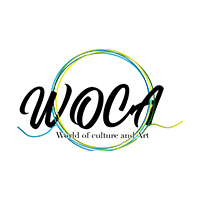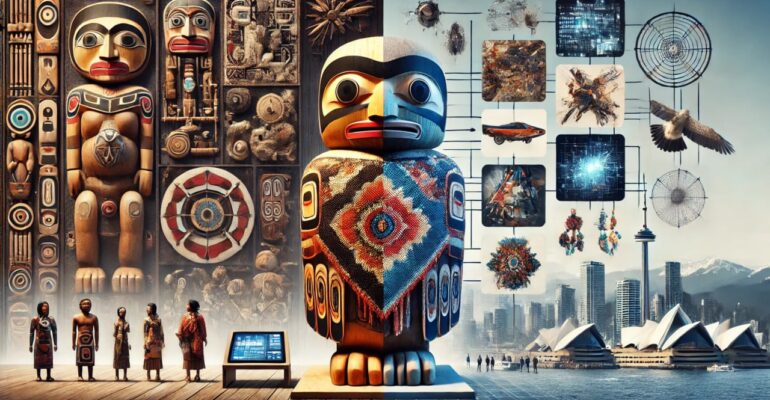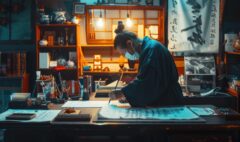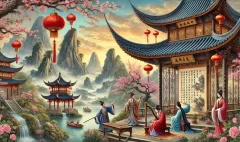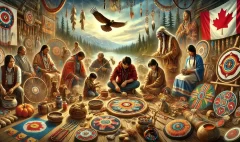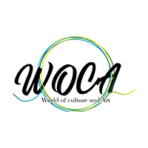Canadian Indigenous Arts: A Journey Through History and Regional Expressions
Canadian Indigenous Arts: A Journey Through History and Regional Expressions
Welcome, art enthusiasts and culture explorers from around the world! Today, we’re embarking on an exciting journey through the rich and diverse landscape of Canadian Indigenous arts. Whether you’re an artist, collector, or simply curious about the cultural tapestry of Canada, this post will introduce you to the fascinating world of Indigenous artistic expressions that have flourished on this land for thousands of years.
As we traverse the vast expanse of Canada, from the rugged Pacific coast to the windswept Arctic and the forested East, we’ll uncover the unique art forms that have emerged from the First Nations, Inuit, and Métis communities. Each brushstroke, carving, and woven thread tells a story of resilience, creativity, and deep connection to the land. So, let’s set out on this colorful adventure and discover the wonders of Canadian Indigenous arts!
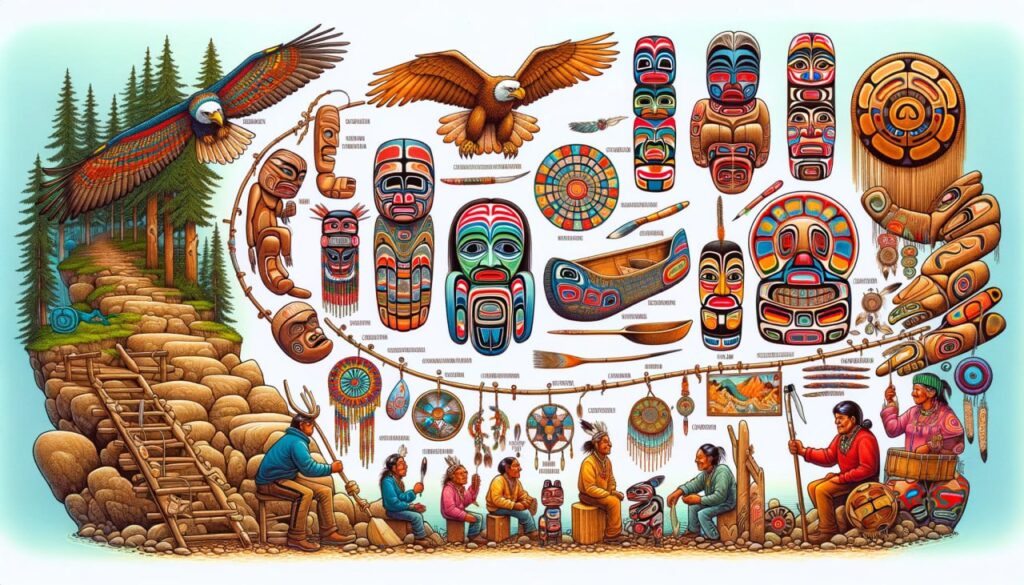
-
The Historical Tapestry of Indigenous Arts in Canada
To truly appreciate the depth and significance of Canadian Indigenous arts, we must first understand its historical roots. The artistic traditions of Indigenous peoples in Canada stretch back millennia, long before European contact.
Ancient Beginnings
Archaeological evidence reveals that Indigenous peoples have been creating art in what is now Canada for at least 12,000 years. Early art forms included:
– Petroglyphs and pictographs: Rock carvings and paintings that often-depicted spiritual beliefs and important events.
– Pottery: Functional and decorative vessels adorned with intricate designs.
– Stone and bone carvings: Small figurines and tools that often had both practical and spiritual purposes.
These early art forms were deeply intertwined with daily life, spiritual practices, and the natural environment. They served as a means of recording history, sharing knowledge, and expressing cultural identity.
The Impact of European Contact
The arrival of European explorers and settlers in the 15th and 16th centuries brought significant changes to Indigenous art practices:
– New materials: The introduction of glass beads, metal tools, and textiles like wool and cotton influenced traditional crafts.
– Trade: The fur trade created new economic opportunities and led to the creation of “souvenir” art for European buyers.
– Cultural suppression: Colonial policies and the residential school system disrupted traditional knowledge transmission, including artistic practices.
Despite these challenges, Indigenous artists adapted and persevered, often incorporating new materials and techniques into their traditional art forms.
Renaissance and Reclamation
The 20th century saw a renaissance in Indigenous arts:
– 1940s-1950s: The emergence of modern Inuit art, particularly soapstone carvings and prints.
– 1960s-1970s: The Woodland School of art, pioneered by Norval Morrisseau, brought Indigenous art into mainstream galleries.
– 1980s-present: A growing movement of contemporary Indigenous artists who blend traditional themes with modern media and global art trends.
This period has been marked by a reclamation of cultural practices and a growing recognition of Indigenous arts in the broader Canadian and international art scenes.
-
Regional Art Forms Across Canada
One of the most fascinating aspects of Canadian Indigenous arts is the incredible diversity of styles and techniques that have developed across different regions. Let’s explore some of these unique regional expressions:
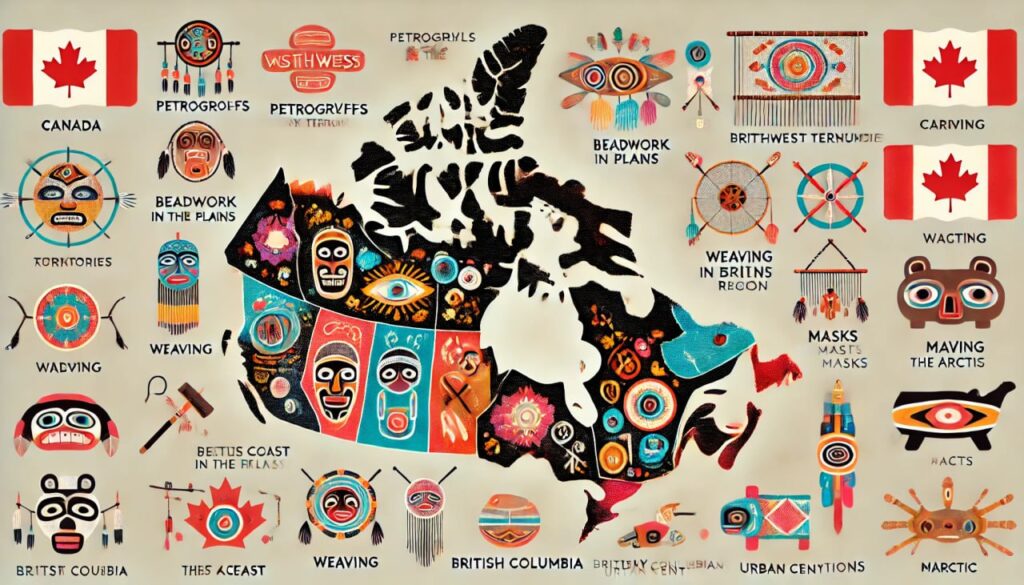
-
The Pacific Northwest Coast
The coastal regions of British Columbia are home to nations like the Haida, Tlingit, and Coast Salish, known for their distinctive and dramatic art styles.
Key art forms include:
– Totem poles: Monumental carvings that tell family histories and clan stories.
– Bentwood boxes: Steam-bent cedar boxes often decorated with painted or carved designs.
– Masks: Intricate carved masks used in ceremonies and storytelling.
– Textiles: Woven items like the famous Chilkat blankets, incorporating complex geometric designs.
Notable artists:
– Bill Reid (Haida): Renowned for his monumental sculptures and jewelry.
– Susan Point (Coast Salish): Known for her innovative prints and public art installations.
-
The Arctic
The vast Arctic regions are home to Inuit communities, whose art has gained international recognition for its unique aesthetic and storytelling qualities.
Key art forms include:
– Soapstone carvings: Sculptures depicting animals, human figures, and scenes from daily life.
– Prints: Stone cut and stencil prints, often featuring stylized animals and spirits.
– Textiles: Wall hangings and clothing featuring appliqué and embroidery.
Notable artists:
– Kenojuak Ashevak: Her iconic print “The Enchanted Owl” has become a symbol of Inuit art.
– Annie Pootoogook: Known for her contemporary drawings of everyday Inuit life.
-
The Plains
The Plains region, stretching across parts of Alberta, Saskatchewan, and Manitoba, is home to nations like the Cree, Blackfoot, and Métis.
Key art forms include:
– Beadwork: Intricate designs adorning clothing, bags, and other items.
– Quillwork: Decorative embroidery using porcupine quills, predating the introduction of glass beads.
– Painted hides: Buffalo hides decorated with geometric designs and pictographs.
Notable artists:
– Christi Belcourt (Métis): Known for her paintings inspired by traditional beadwork patterns.
– Kent Monkman (Cree): His provocative paintings challenge historical narratives and stereotypes.
-
The Woodlands
The Woodlands region covers much of Ontario, Quebec, and the Atlantic provinces, and is home to nations like the Anishinaabe, Haudenosaunee, and Mi’kmaq.
Key art forms include:
– Birchbark crafts: Containers, canoes, and artworks made from birchbark.
– Porcupine quillwork: Intricate designs created by weaving dyed porcupine quills.
– Wampum belts: Beaded belts used to record treaties and important events.
Notable artists:
– Norval Morrisseau (Ojibwe): Founder of the Woodland School of art, known for his vibrant, spiritual paintings.
– Daphne Odjig (Odawa-Potawatomi): Her work blends traditional themes with modernist styles.
-
The Spiritual and Cultural Significance of Indigenous Art
To truly appreciate Canadian Indigenous arts, it’s crucial to understand that these creations are more than just beautiful objects—they’re deeply intertwined with spiritual beliefs, cultural practices, and connection to the land.
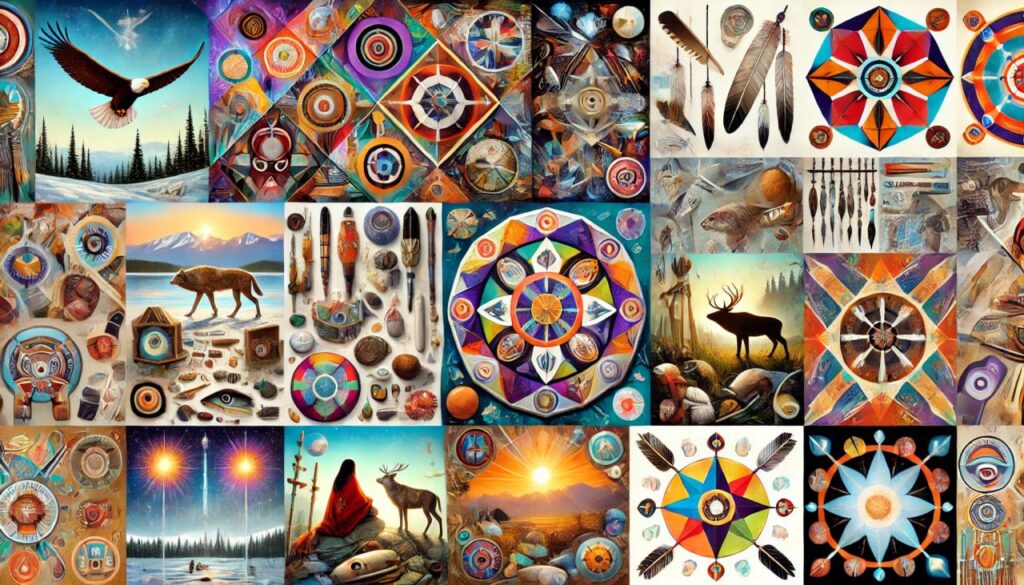
Many Indigenous artworks incorporate symbols and motifs that have specific meanings within their culture:
– The medicine wheel: Represents balance and the cyclical nature of life.
– Animal spirits: Often symbolize specific traits or teachings.
– Geometric patterns: May represent natural elements like mountains, rivers, or stars.
The creation of art itself is often a spiritual practice. Many artists prepare themselves through prayer or ceremony before beginning a piece. The materials used may be gathered with specific protocols, acknowledging the gifts of the natural world. It’s important to approach this knowledge with respect, recognizing that some meanings may be sacred or not fully shared with outsiders.
-
Contemporary Indigenous Art: Bridging Tradition and Innovation
While rooted in ancient traditions, Canadian Indigenous art is far from static. Contemporary Indigenous artists are pushing boundaries, blending traditional techniques with modern mediums and themes.
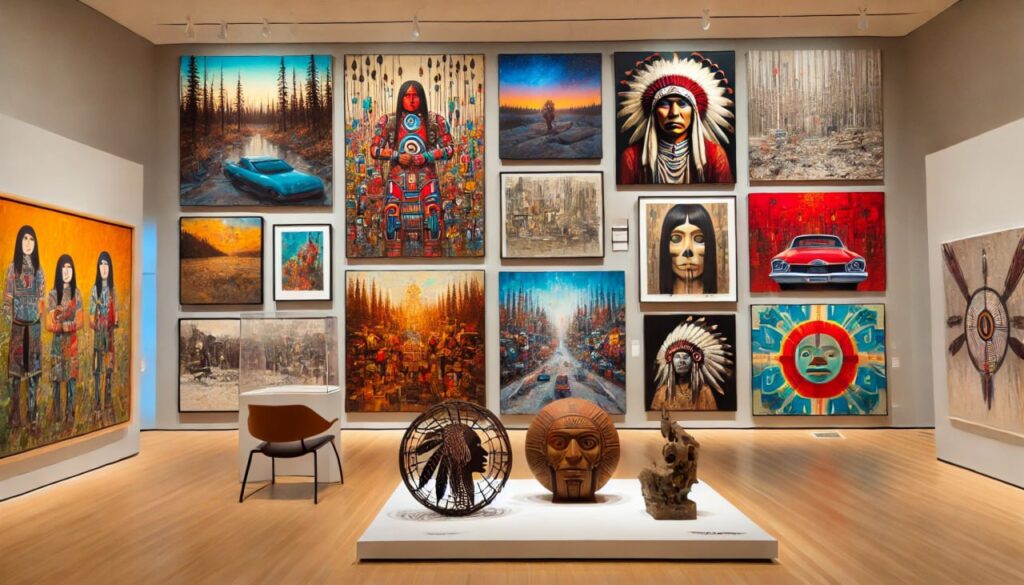
Today’s Indigenous artists are tackling contemporary issues through their work, addressing topics like identity, environmental concerns, and social justice. They’re using everything from acrylic paints and digital media to performance art and film to express their vision.
Some notable contemporary Indigenous artists include:
– Rebecca Belmore (Anishinaabe): Her powerful installations address colonialism and violence against Indigenous women.
– Brian Jungen (Dane-zaa): Famous for transforming everyday objects into sculptures that comment on consumerism and Indigenous identity.
– Sonny Assu (Kwakwaka’wakw): His work combines Indigenous iconography with pop culture references to explore the impact of colonization on Indigenous culture.
These artists, among many others, are gaining recognition on the world stage, showcasing the vibrancy and relevance of Indigenous art in the 21st century.
-
Supporting and Collecting Indigenous Art
If you’re inspired by Canadian Indigenous arts, there are many ways to show your support and even start your own collection.
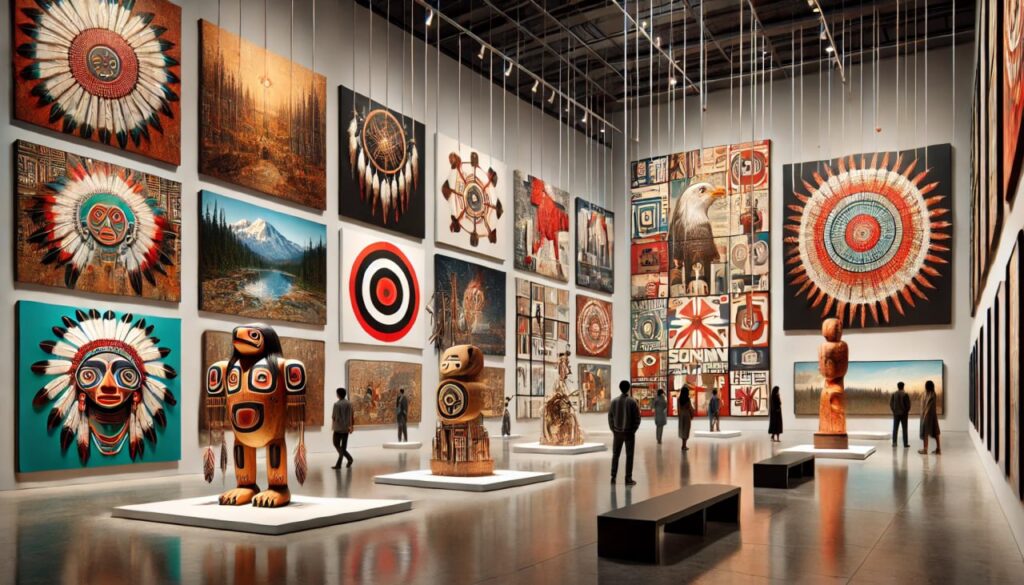
Here are some tips for supporting Indigenous artists and acquiring authentic artwork:
- Visit Indigenous-owned galleries and cultural centers across Canada.
- Attend Indigenous art markets and festivals, where you can often meet artists in person.
- Look for certification marks like the Igloo Tag for Inuit art, which ensure authenticity.
- Support organizations that promote Indigenous arts, such as the Indigenous Art Centre or the Inuit Art Foundation.
- When purchasing, ask about the artist and the story behind the piece—many galleries and artists are happy to share this information.
Remember, by purchasing authentic Indigenous art, you’re not just acquiring a beautiful object; you’re supporting living cultures and traditions.
-
The Future of Canadian Indigenous Arts
As we look to the future, Canadian Indigenous arts continue to evolve and flourish. New generations of artists are finding innovative ways to express their identities and experiences, while also honoring their cultural heritage.
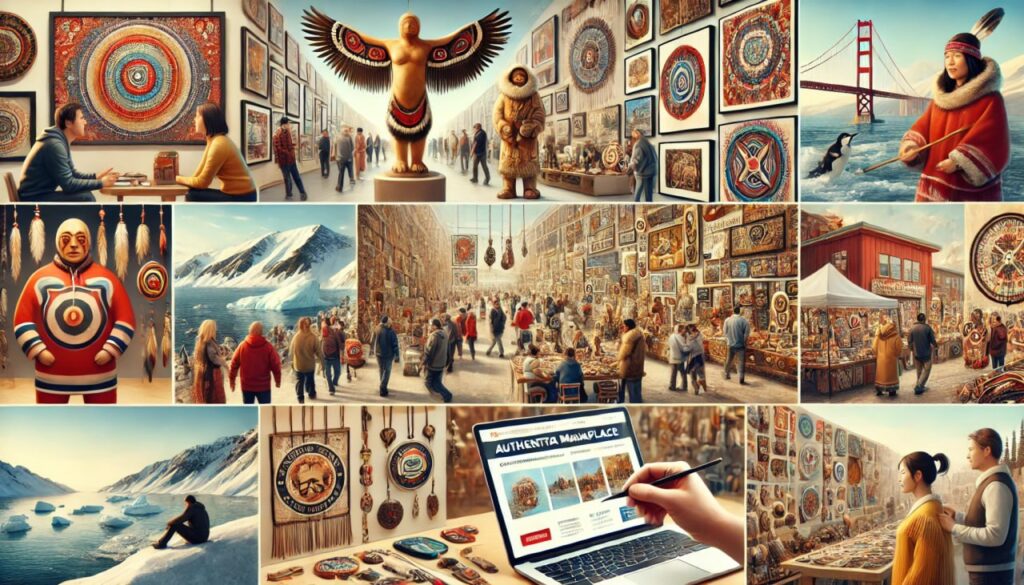
Some exciting developments in the field include:
– Digital art and animation: Artists like Skawennati (Mohawk) are using virtual environments to explore Indigenous futurisms.
– Fashion design: Designers like Sage Paul (Dene) are bringing Indigenous aesthetics to the runway.
– Film and media: Indigenous filmmakers are telling their stories through powerful documentaries and feature films.
– Public art: Large-scale installations and murals by Indigenous artists are increasingly visible in urban spaces.
These new forms of expression are not only keeping Indigenous cultures vibrant and relevant but are also challenging mainstream perceptions of Indigenous art and identity.
Conclusion: A Living, Breathing Artistic Tradition
As we conclude our journey through the world of Canadian Indigenous arts, I hope you’ve gained a new appreciation for the depth, diversity, and vitality of these artistic traditions. From ancient craft techniques to cutting-edge contemporary expressions, Indigenous art in Canada continues to evolve while staying true to its roots.
Canadian Indigenous arts offer us a window into rich cultures, complex histories, and profound connections to the land. By engaging with this art—whether through admiring, learning, or collecting—we can all play a part in supporting and celebrating these important cultural expressions.
I encourage you to continue exploring Canadian Indigenous arts. Visit a gallery, attend a cultural event, or simply dive deeper into learning about the artists and traditions that interest you most. The world of Canadian Indigenous arts is vast and endlessly fascinating—there’s always more to discover! Now, We’d love to hear from you! Have you encountered Canadian Indigenous art before? What aspects of it intrigue you the most? Do you have any favorite Indigenous artists or artworks? Share your thoughts and experiences in the comments below—let’s keep this conversation going and spread the word about the incredible world of Canadian Indigenous arts!
